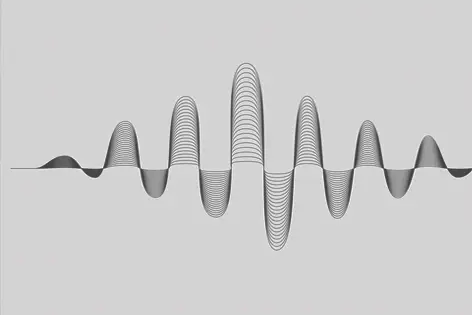To easily understand what is sound waves, imagine dropping a pebble in a still pond. Ripples emanate outwards, disturbing the surface with a wave-like dance. Sound behaves similarly, though instead of water, it vibrates molecules in the air. These vibrations, known as sound waves, carry the essence of a sound as they travel, ultimately reaching our ears and triggering the fascinating journey of auditory perception.
Sound waves are fascinating ripples in the air, orchestrated by the vibrations of objects in motion. When an object vibrates, it displaces air molecules, creating compressions and rarefactions that propagate through the air. These pressure changes are what we perceive as sound.
Understanding these properties is the first step in understanding what is sound. It is like deciphering the language of sound. The pitch, loudness, and timbre are the vocabulary through which the symphony of our surroundings communicates with us.
For sound to reach our ears, it needs to travel. It does this most efficiently through air, with each molecule bumping into its neighbors to relay the vibrations forward. In solids and liquids, sound travels even faster, creating unique listening experiences like hearing footsteps through the floor or whales communicating underwater.
This journey of transmission is an integral part of the symphony of sound. The speed, direction, and quality of sound transmission vary depending on the medium through which it travels. Understanding this transmission is like peeling back the layers of the sonic universe, revealing how vibrations dance through different materials to create the diverse soundscape we experience.
From the fluttering wings of butterflies to the booming drumbeat of a rock band, every object capable of vibration can be a source of sound. The way these vibrations occur defines the sound’s character. Plucking a guitar string or blowing air through a flute sets the air molecules dancing, while striking a cymbal or clapping our hands generate sudden energy bursts that translate into sharp, percussive sounds.
Instruments, both natural and man-made, contribute to the grand orchestra of sound. Each has its unique signature, creating a rich tapestry of tones and rhythms. Exploring these sound sources is like unraveling the threads of a musical composition, discovering the diverse elements that come together to create the harmonious whole.
This is just the first note in our exploration of the captivating world of sound. In the coming articles, we’ll delve deeper into the physics of sound waves and the properties that govern its behavior, the marvels of human perception, and the ingenious ways we harness and manipulate sound to create music, communicate, and shape our experiences. So, buckle up and prepare to embark on a sonic journey that will awaken your senses and leave you marveling at the invisible orchestra that surrounds us all.
A dedicated writer for White Noise Acoustics, passionately unravels the world of Acoustic Treatment through his insightful articles. With a keen ear for sonic intricacies, Mukesh’s expertise transforms spaces, ensuring harmony between sound and environment. His words resonate, inspiring acoustic enthusiasts to elevate their auditory experiences.
[{"id":3087,"link":"https:\/\/whitenoiseacoustics.in\/maximizing-space-in-a-small-home-theater\/","name":"maximizing-space-in-a-small-home-theater","thumbnail":{"url":"https:\/\/whitenoiseacoustics.in\/wp-content\/uploads\/2024\/04\/Maximizing-Space-in-a-Small-Home-Theater.webp","alt":"Maximizing-Space-in-a-Small-Home-Theater"},"title":"Maximizing Space in a Small Home Theater","excerpt":"In the world of home entertainment, creating a captivating theater experience often conjures up images of expansive rooms with plush seating, towering speakers, and giant screens. However, the reality for many enthusiasts is quite different.","content":"Introduction In the world of home entertainment, creating a captivating theater experience often conjures up images of expansive rooms with plush seating, floorstanding speakers, and","author":{"name":"Mukesh Ranjan","link":"https:\/\/whitenoiseacoustics.in\/author\/mukesh\/"},"date":"Apr 16, 2024","dateGMT":"2024-04-16 12:33:39","modifiedDate":"2024-05-07 12:25:29","modifiedDateGMT":"2024-05-07 12:25:29","commentCount":"0","commentStatus":"open","categories":{"coma":"<a href=\"https:\/\/whitenoiseacoustics.in\/category\/home-theatre\/\" rel=\"category tag\">Home Theatre<\/a>, <a href=\"https:\/\/whitenoiseacoustics.in\/category\/acoustic-treatment\/\" rel=\"category tag\">Acoustic Treatment<\/a>, <a href=\"https:\/\/whitenoiseacoustics.in\/category\/audio-video\/\" rel=\"category tag\">Audio Video<\/a>, <a href=\"https:\/\/whitenoiseacoustics.in\/category\/blog\/\" rel=\"category tag\">Blog<\/a>, <a href=\"https:\/\/whitenoiseacoustics.in\/category\/audio-video\/projector-and-screens\/\" rel=\"category tag\">Projector and Screens<\/a>, <a href=\"https:\/\/whitenoiseacoustics.in\/category\/audio-video\/speakers\/\" rel=\"category tag\">Speakers<\/a>","space":"<a href=\"https:\/\/whitenoiseacoustics.in\/category\/home-theatre\/\" rel=\"category tag\">Home Theatre<\/a> <a href=\"https:\/\/whitenoiseacoustics.in\/category\/acoustic-treatment\/\" rel=\"category tag\">Acoustic Treatment<\/a> <a href=\"https:\/\/whitenoiseacoustics.in\/category\/audio-video\/\" rel=\"category tag\">Audio Video<\/a> <a href=\"https:\/\/whitenoiseacoustics.in\/category\/blog\/\" rel=\"category tag\">Blog<\/a> <a href=\"https:\/\/whitenoiseacoustics.in\/category\/audio-video\/projector-and-screens\/\" rel=\"category tag\">Projector and Screens<\/a> <a href=\"https:\/\/whitenoiseacoustics.in\/category\/audio-video\/speakers\/\" rel=\"category tag\">Speakers<\/a>"},"taxonomies":{"post_tag":"<a href='https:\/\/whitenoiseacoustics.in\/tag\/acoustic-panels\/' rel='post_tag'>Acoustic Panels<\/a><a href='https:\/\/whitenoiseacoustics.in\/tag\/acoustic-treatment\/' rel='post_tag'>Acoustic Treatment<\/a><a href='https:\/\/whitenoiseacoustics.in\/tag\/audio-video-system\/' rel='post_tag'>Audio Video System<\/a><a href='https:\/\/whitenoiseacoustics.in\/tag\/cinematic-experience\/' rel='post_tag'>Cinematic Experience<\/a><a href='https:\/\/whitenoiseacoustics.in\/tag\/home-entertainment\/' rel='post_tag'>Home Entertainment<\/a><a href='https:\/\/whitenoiseacoustics.in\/tag\/home-theater\/' rel='post_tag'>Home Theater<\/a><a href='https:\/\/whitenoiseacoustics.in\/tag\/home-theater-acoustic-treatment\/' rel='post_tag'>Home Theater Acoustic Treatment<\/a><a href='https:\/\/whitenoiseacoustics.in\/tag\/home-theater-lighting\/' rel='post_tag'>Home Theater Lighting<\/a><a href='https:\/\/whitenoiseacoustics.in\/tag\/room-acoustics\/' rel='post_tag'>Room Acoustics<\/a><a href='https:\/\/whitenoiseacoustics.in\/tag\/smart-home-theater\/' rel='post_tag'>Smart Home Theater<\/a>"},"readTime":{"min":7,"sec":43},"status":"publish"},{"id":3003,"link":"https:\/\/whitenoiseacoustics.in\/selecting-the-best-screen-size-for-your-home-theater\/","name":"selecting-the-best-screen-size-for-your-home-theater","thumbnail":{"url":"https:\/\/whitenoiseacoustics.in\/wp-content\/uploads\/2024\/03\/Selecting-the-Best-Screen-Size-for-Your-Home-Theater.webp","alt":"Selecting-the-Best-Screen-Size-for-Your-Home-Theater"},"title":"Selecting the Best Screen Size for Your Home Theater","excerpt":"In the realm of home entertainment, few experiences rival the immersive bliss of a well-designed home theater. Picture yourself sinking into a plush couch, surrounded by friends or family, as the room fills with the sights and sounds of your favorite movies or games.","content":"Introduction In the realm of home entertainment, few experiences rival the immersive bliss of a well-designed home theater. Picture yourself sinking into a plush couch,","author":{"name":"Mukesh Ranjan","link":"https:\/\/whitenoiseacoustics.in\/author\/mukesh\/"},"date":"Mar 21, 2024","dateGMT":"2024-03-21 14:40:14","modifiedDate":"2024-05-07 12:31:54","modifiedDateGMT":"2024-05-07 12:31:54","commentCount":"0","commentStatus":"open","categories":{"coma":"<a href=\"https:\/\/whitenoiseacoustics.in\/category\/audio-video\/\" rel=\"category tag\">Audio Video<\/a>, <a href=\"https:\/\/whitenoiseacoustics.in\/category\/blog\/\" rel=\"category tag\">Blog<\/a>, <a href=\"https:\/\/whitenoiseacoustics.in\/category\/home-theatre\/\" rel=\"category tag\">Home Theatre<\/a>, <a href=\"https:\/\/whitenoiseacoustics.in\/category\/audio-video\/projector-and-screens\/\" rel=\"category tag\">Projector and Screens<\/a>","space":"<a href=\"https:\/\/whitenoiseacoustics.in\/category\/audio-video\/\" rel=\"category tag\">Audio Video<\/a> <a href=\"https:\/\/whitenoiseacoustics.in\/category\/blog\/\" rel=\"category tag\">Blog<\/a> <a href=\"https:\/\/whitenoiseacoustics.in\/category\/home-theatre\/\" rel=\"category tag\">Home Theatre<\/a> <a href=\"https:\/\/whitenoiseacoustics.in\/category\/audio-video\/projector-and-screens\/\" rel=\"category tag\">Projector and Screens<\/a>"},"taxonomies":{"post_tag":"<a href='https:\/\/whitenoiseacoustics.in\/tag\/audio-video-system\/' rel='post_tag'>Audio Video System<\/a><a href='https:\/\/whitenoiseacoustics.in\/tag\/cinematic-experience\/' rel='post_tag'>Cinematic Experience<\/a><a href='https:\/\/whitenoiseacoustics.in\/tag\/home-entertainment\/' rel='post_tag'>Home Entertainment<\/a><a href='https:\/\/whitenoiseacoustics.in\/tag\/home-theater\/' rel='post_tag'>Home Theater<\/a><a href='https:\/\/whitenoiseacoustics.in\/tag\/immersive-viewing\/' rel='post_tag'>immersive viewing<\/a><a href='https:\/\/whitenoiseacoustics.in\/tag\/movie-time\/' rel='post_tag'>movie time<\/a><a href='https:\/\/whitenoiseacoustics.in\/tag\/projector-screens\/' rel='post_tag'>projector screens<\/a><a href='https:\/\/whitenoiseacoustics.in\/tag\/projectors\/' rel='post_tag'>projectors<\/a><a href='https:\/\/whitenoiseacoustics.in\/tag\/sound-production\/' rel='post_tag'>sound production<\/a><a href='https:\/\/whitenoiseacoustics.in\/tag\/soundscape\/' rel='post_tag'>soundscape<\/a>"},"readTime":{"min":9,"sec":44},"status":"publish"},{"id":2717,"link":"https:\/\/whitenoiseacoustics.in\/longitudinal-waves-in-sound\/","name":"longitudinal-waves-in-sound","thumbnail":{"url":"https:\/\/whitenoiseacoustics.in\/wp-content\/uploads\/2024\/01\/Longitudinal-Waves-in-Sound.webp","alt":"Longitudinal-Waves-in-Sound"},"title":"Longitudinal Waves in Sound","excerpt":"To comprehend the physics of sound, we must first grasp the fundamentals of longitudinal waves. In the realm of acoustics, longitudinal waves manifest as vibrations that occur parallel to the direction of the wave.","content":"Introduction In the symphony of physics, sound waves play a melodious role, and among them, longitudinal waves take center stage. Understanding the intricate dance of","author":{"name":"Mukesh Ranjan","link":"https:\/\/whitenoiseacoustics.in\/author\/mukesh\/"},"date":"Jan 10, 2024","dateGMT":"2024-01-10 14:31:19","modifiedDate":"2024-01-10 14:39:14","modifiedDateGMT":"2024-01-10 14:39:14","commentCount":"0","commentStatus":"open","categories":{"coma":"<a href=\"https:\/\/whitenoiseacoustics.in\/category\/blog\/\" rel=\"category tag\">Blog<\/a>, <a href=\"https:\/\/whitenoiseacoustics.in\/category\/sound\/basics\/\" rel=\"category tag\">Basics<\/a>, <a href=\"https:\/\/whitenoiseacoustics.in\/category\/sound\/\" rel=\"category tag\">Sound<\/a>","space":"<a href=\"https:\/\/whitenoiseacoustics.in\/category\/blog\/\" rel=\"category tag\">Blog<\/a> <a href=\"https:\/\/whitenoiseacoustics.in\/category\/sound\/basics\/\" rel=\"category tag\">Basics<\/a> <a href=\"https:\/\/whitenoiseacoustics.in\/category\/sound\/\" rel=\"category tag\">Sound<\/a>"},"taxonomies":{"post_tag":"<a href='https:\/\/whitenoiseacoustics.in\/tag\/ministry-of-sound\/' rel='post_tag'>ministry of sound<\/a><a href='https:\/\/whitenoiseacoustics.in\/tag\/sound\/' rel='post_tag'>sound<\/a><a href='https:\/\/whitenoiseacoustics.in\/tag\/sound-check\/' rel='post_tag'>sound check<\/a><a href='https:\/\/whitenoiseacoustics.in\/tag\/sound-fx\/' rel='post_tag'>sound fx<\/a><a href='https:\/\/whitenoiseacoustics.in\/tag\/sound-production\/' rel='post_tag'>sound production<\/a><a href='https:\/\/whitenoiseacoustics.in\/tag\/sound-quality\/' rel='post_tag'>sound quality<\/a><a href='https:\/\/whitenoiseacoustics.in\/tag\/sound-systems\/' rel='post_tag'>sound systems<\/a><a href='https:\/\/whitenoiseacoustics.in\/tag\/sound-tech\/' rel='post_tag'>sound tech<\/a><a href='https:\/\/whitenoiseacoustics.in\/tag\/sound-waves\/' rel='post_tag'>sound waves<\/a><a href='https:\/\/whitenoiseacoustics.in\/tag\/soundscape\/' rel='post_tag'>soundscape<\/a>"},"readTime":{"min":5,"sec":22},"status":"publish"},{"id":2700,"link":"https:\/\/whitenoiseacoustics.in\/compression-and-rarefaction\/","name":"compression-and-rarefaction","thumbnail":{"url":"https:\/\/whitenoiseacoustics.in\/wp-content\/uploads\/2024\/01\/Compression-and-Rarefaction-1.webp","alt":"Compression-and-Rarefaction-1"},"title":"Understanding Compression and Rarefaction in the Physics of Sound Waves","excerpt":"At the core of sound wave dynamics lies the concept of Compression. Imagine standing in front of a powerful speaker at a rock concert. The thumping bass and resonating melodies are a result of air particles being tightly packed together in a region","content":"Introduction The universe is a symphony of vibrations, and at the heart of this symphony lies the fascinating world of sound waves. As we delve","author":{"name":"Mukesh Ranjan","link":"https:\/\/whitenoiseacoustics.in\/author\/mukesh\/"},"date":"Jan 10, 2024","dateGMT":"2024-01-10 13:44:34","modifiedDate":"2024-01-10 14:40:21","modifiedDateGMT":"2024-01-10 14:40:21","commentCount":"0","commentStatus":"open","categories":{"coma":"<a href=\"https:\/\/whitenoiseacoustics.in\/category\/sound\/\" rel=\"category tag\">Sound<\/a>, <a href=\"https:\/\/whitenoiseacoustics.in\/category\/sound\/basics\/\" rel=\"category tag\">Basics<\/a>, <a href=\"https:\/\/whitenoiseacoustics.in\/category\/blog\/\" rel=\"category tag\">Blog<\/a>","space":"<a href=\"https:\/\/whitenoiseacoustics.in\/category\/sound\/\" rel=\"category tag\">Sound<\/a> <a href=\"https:\/\/whitenoiseacoustics.in\/category\/sound\/basics\/\" rel=\"category tag\">Basics<\/a> <a href=\"https:\/\/whitenoiseacoustics.in\/category\/blog\/\" rel=\"category tag\">Blog<\/a>"},"taxonomies":{"post_tag":"<a href='https:\/\/whitenoiseacoustics.in\/tag\/ministry-of-sound\/' rel='post_tag'>ministry of sound<\/a><a href='https:\/\/whitenoiseacoustics.in\/tag\/sound\/' rel='post_tag'>sound<\/a><a href='https:\/\/whitenoiseacoustics.in\/tag\/sound-check\/' rel='post_tag'>sound check<\/a><a href='https:\/\/whitenoiseacoustics.in\/tag\/sound-fx\/' rel='post_tag'>sound fx<\/a><a href='https:\/\/whitenoiseacoustics.in\/tag\/sound-production\/' rel='post_tag'>sound production<\/a><a href='https:\/\/whitenoiseacoustics.in\/tag\/sound-quality\/' rel='post_tag'>sound quality<\/a><a href='https:\/\/whitenoiseacoustics.in\/tag\/sound-systems\/' rel='post_tag'>sound systems<\/a><a href='https:\/\/whitenoiseacoustics.in\/tag\/sound-tech\/' rel='post_tag'>sound tech<\/a><a href='https:\/\/whitenoiseacoustics.in\/tag\/sound-waves\/' rel='post_tag'>sound waves<\/a><a href='https:\/\/whitenoiseacoustics.in\/tag\/soundscape\/' rel='post_tag'>soundscape<\/a>"},"readTime":{"min":6,"sec":29},"status":"publish"},{"id":2547,"link":"https:\/\/whitenoiseacoustics.in\/the-physics-of-sound-waves\/","name":"the-physics-of-sound-waves","thumbnail":{"url":"https:\/\/whitenoiseacoustics.in\/wp-content\/uploads\/2024\/01\/Physics-of-Sound-waves-1.webp","alt":"Physics-of-Sound-waves-1"},"title":"The Physics of Sound waves: Understanding Wave Propagation","excerpt":"To comprehend the physics of sound waves, one must first grasp the fundamentals of sound waves. Sound waves are mechanical waves that travel through a medium, typically air, water, or solids. They are created by the vibration of a source, such as a vibrating string, vocal cords, or a drum membrane.","content":"Introduction Sound is an intricate phenomenon that captivates our senses and shapes our perception of the world. The mesmerizing melodies of a song, the rhythmic","author":{"name":"Mukesh Ranjan","link":"https:\/\/whitenoiseacoustics.in\/author\/mukesh\/"},"date":"Jan 10, 2024","dateGMT":"2024-01-10 12:38:48","modifiedDate":"2024-01-10 14:40:43","modifiedDateGMT":"2024-01-10 14:40:43","commentCount":"0","commentStatus":"open","categories":{"coma":"<a href=\"https:\/\/whitenoiseacoustics.in\/category\/blog\/\" rel=\"category tag\">Blog<\/a>, <a href=\"https:\/\/whitenoiseacoustics.in\/category\/sound\/basics\/\" rel=\"category tag\">Basics<\/a>, <a href=\"https:\/\/whitenoiseacoustics.in\/category\/sound\/\" rel=\"category tag\">Sound<\/a>","space":"<a href=\"https:\/\/whitenoiseacoustics.in\/category\/blog\/\" rel=\"category tag\">Blog<\/a> <a href=\"https:\/\/whitenoiseacoustics.in\/category\/sound\/basics\/\" rel=\"category tag\">Basics<\/a> <a href=\"https:\/\/whitenoiseacoustics.in\/category\/sound\/\" rel=\"category tag\">Sound<\/a>"},"taxonomies":{"post_tag":"<a href='https:\/\/whitenoiseacoustics.in\/tag\/ministry-of-sound\/' rel='post_tag'>ministry of sound<\/a><a href='https:\/\/whitenoiseacoustics.in\/tag\/sound\/' rel='post_tag'>sound<\/a><a href='https:\/\/whitenoiseacoustics.in\/tag\/sound-check\/' rel='post_tag'>sound check<\/a><a href='https:\/\/whitenoiseacoustics.in\/tag\/sound-fx\/' rel='post_tag'>sound fx<\/a><a href='https:\/\/whitenoiseacoustics.in\/tag\/sound-production\/' rel='post_tag'>sound production<\/a><a href='https:\/\/whitenoiseacoustics.in\/tag\/sound-quality\/' rel='post_tag'>sound quality<\/a><a href='https:\/\/whitenoiseacoustics.in\/tag\/sound-systems\/' rel='post_tag'>sound systems<\/a><a href='https:\/\/whitenoiseacoustics.in\/tag\/sound-tech\/' rel='post_tag'>sound tech<\/a><a href='https:\/\/whitenoiseacoustics.in\/tag\/sound-waves\/' rel='post_tag'>sound waves<\/a><a href='https:\/\/whitenoiseacoustics.in\/tag\/soundscape\/' rel='post_tag'>soundscape<\/a>"},"readTime":{"min":5,"sec":59},"status":"publish"},{"id":2667,"link":"https:\/\/whitenoiseacoustics.in\/what-is-wavelength-in-sound-waves\/","name":"what-is-wavelength-in-sound-waves","thumbnail":{"url":"https:\/\/whitenoiseacoustics.in\/wp-content\/uploads\/2024\/01\/Wavelength-in-Sound-Waves-1.webp","alt":"Wavelength-in-Sound-Waves-1"},"title":"What is Wavelength in Sound Waves","excerpt":"The world of sound waves is a fascinating realm where invisible forces orchestrate the melodies we hear every day. To truly understand the essence of sound, one must delve into the intricacies of its fundamental elements.","content":"Introduction The world of sound waves is a fascinating realm where invisible forces orchestrate the melodies we hear every day. To truly understand the essence","author":{"name":"Mukesh Ranjan","link":"https:\/\/whitenoiseacoustics.in\/author\/mukesh\/"},"date":"Jan 9, 2024","dateGMT":"2024-01-09 14:32:22","modifiedDate":"2024-01-10 13:05:59","modifiedDateGMT":"2024-01-10 13:05:59","commentCount":"0","commentStatus":"open","categories":{"coma":"<a href=\"https:\/\/whitenoiseacoustics.in\/category\/blog\/\" rel=\"category tag\">Blog<\/a>, <a href=\"https:\/\/whitenoiseacoustics.in\/category\/sound\/basics\/\" rel=\"category tag\">Basics<\/a>, <a href=\"https:\/\/whitenoiseacoustics.in\/category\/sound\/\" rel=\"category tag\">Sound<\/a>","space":"<a href=\"https:\/\/whitenoiseacoustics.in\/category\/blog\/\" rel=\"category tag\">Blog<\/a> <a href=\"https:\/\/whitenoiseacoustics.in\/category\/sound\/basics\/\" rel=\"category tag\">Basics<\/a> <a href=\"https:\/\/whitenoiseacoustics.in\/category\/sound\/\" rel=\"category tag\">Sound<\/a>"},"taxonomies":{"post_tag":"<a href='https:\/\/whitenoiseacoustics.in\/tag\/ministry-of-sound\/' rel='post_tag'>ministry of sound<\/a><a href='https:\/\/whitenoiseacoustics.in\/tag\/sound\/' rel='post_tag'>sound<\/a><a href='https:\/\/whitenoiseacoustics.in\/tag\/sound-check\/' rel='post_tag'>sound check<\/a><a href='https:\/\/whitenoiseacoustics.in\/tag\/sound-fx\/' rel='post_tag'>sound fx<\/a><a href='https:\/\/whitenoiseacoustics.in\/tag\/sound-production\/' rel='post_tag'>sound production<\/a><a href='https:\/\/whitenoiseacoustics.in\/tag\/sound-quality\/' rel='post_tag'>sound quality<\/a><a href='https:\/\/whitenoiseacoustics.in\/tag\/sound-systems\/' rel='post_tag'>sound systems<\/a><a href='https:\/\/whitenoiseacoustics.in\/tag\/sound-tech\/' rel='post_tag'>sound tech<\/a><a href='https:\/\/whitenoiseacoustics.in\/tag\/sound-waves\/' rel='post_tag'>sound waves<\/a><a href='https:\/\/whitenoiseacoustics.in\/tag\/soundscape\/' rel='post_tag'>soundscape<\/a>"},"readTime":{"min":6,"sec":30},"status":"publish"},{"id":2652,"link":"https:\/\/whitenoiseacoustics.in\/what-is-amplitude-in-sound-waves\/","name":"what-is-amplitude-in-sound-waves","thumbnail":{"url":"https:\/\/whitenoiseacoustics.in\/wp-content\/uploads\/2024\/01\/What-is-amplitude-is-sound-waves-1.webp","alt":"amplitude-is-sound-waves-1"},"title":"What is Amplitude in Sound Waves","excerpt":"Amplitude is a fundamental property of sound waves, describing the extent of displacement of air particles caused by the passage of a sound wave. In simpler terms, it represents the intensity or strength of a sound wave.","content":"Introduction Sound, a fundamental aspect of our daily lives, is a complex phenomenon that can be analyzed and understood through various properties and Physics of","author":{"name":"Mukesh Ranjan","link":"https:\/\/whitenoiseacoustics.in\/author\/mukesh\/"},"date":"Jan 9, 2024","dateGMT":"2024-01-09 12:08:38","modifiedDate":"2024-01-10 14:06:30","modifiedDateGMT":"2024-01-10 14:06:30","commentCount":"0","commentStatus":"open","categories":{"coma":"<a href=\"https:\/\/whitenoiseacoustics.in\/category\/blog\/\" rel=\"category tag\">Blog<\/a>, <a href=\"https:\/\/whitenoiseacoustics.in\/category\/sound\/basics\/\" rel=\"category tag\">Basics<\/a>, <a href=\"https:\/\/whitenoiseacoustics.in\/category\/sound\/\" rel=\"category tag\">Sound<\/a>","space":"<a href=\"https:\/\/whitenoiseacoustics.in\/category\/blog\/\" rel=\"category tag\">Blog<\/a> <a href=\"https:\/\/whitenoiseacoustics.in\/category\/sound\/basics\/\" rel=\"category tag\">Basics<\/a> <a href=\"https:\/\/whitenoiseacoustics.in\/category\/sound\/\" rel=\"category tag\">Sound<\/a>"},"taxonomies":{"post_tag":"<a href='https:\/\/whitenoiseacoustics.in\/tag\/ministry-of-sound\/' rel='post_tag'>ministry of sound<\/a><a href='https:\/\/whitenoiseacoustics.in\/tag\/sound\/' rel='post_tag'>sound<\/a><a href='https:\/\/whitenoiseacoustics.in\/tag\/sound-check\/' rel='post_tag'>sound check<\/a><a href='https:\/\/whitenoiseacoustics.in\/tag\/sound-fx\/' rel='post_tag'>sound fx<\/a><a href='https:\/\/whitenoiseacoustics.in\/tag\/sound-production\/' rel='post_tag'>sound production<\/a><a href='https:\/\/whitenoiseacoustics.in\/tag\/sound-quality\/' rel='post_tag'>sound quality<\/a><a href='https:\/\/whitenoiseacoustics.in\/tag\/sound-systems\/' rel='post_tag'>sound systems<\/a><a href='https:\/\/whitenoiseacoustics.in\/tag\/sound-tech\/' rel='post_tag'>sound tech<\/a><a href='https:\/\/whitenoiseacoustics.in\/tag\/sound-waves\/' rel='post_tag'>sound waves<\/a><a href='https:\/\/whitenoiseacoustics.in\/tag\/soundscape\/' rel='post_tag'>soundscape<\/a>"},"readTime":{"min":6,"sec":54},"status":"publish"},{"id":2641,"link":"https:\/\/whitenoiseacoustics.in\/frequency-in-sound-waves\/","name":"frequency-in-sound-waves","thumbnail":{"url":"https:\/\/whitenoiseacoustics.in\/wp-content\/uploads\/2023\/12\/What-is-frequency-is-sound-waves-1.webp","alt":"What-is-frequency-in-sound-waves-1"},"title":"What is Frequency in Sound Waves","excerpt":"Sound, a fascinating phenomenon that surrounds us every day, plays a pivotal role in our lives. Whether it's the melodious notes of your favorite song or the rhythmic patter of raindrops, sound waves are at the heart of this auditory experience.","content":"Introduction Sound, a fascinating phenomenon that surrounds us every day, plays a pivotal role in our lives. Whether it's the melodious notes of your favorite","author":{"name":"Mukesh Ranjan","link":"https:\/\/whitenoiseacoustics.in\/author\/mukesh\/"},"date":"Dec 30, 2023","dateGMT":"2023-12-30 13:18:17","modifiedDate":"2024-01-10 13:10:07","modifiedDateGMT":"2024-01-10 13:10:07","commentCount":"0","commentStatus":"open","categories":{"coma":"<a href=\"https:\/\/whitenoiseacoustics.in\/category\/sound\/\" rel=\"category tag\">Sound<\/a>, <a href=\"https:\/\/whitenoiseacoustics.in\/category\/sound\/basics\/\" rel=\"category tag\">Basics<\/a>, <a href=\"https:\/\/whitenoiseacoustics.in\/category\/blog\/\" rel=\"category tag\">Blog<\/a>","space":"<a href=\"https:\/\/whitenoiseacoustics.in\/category\/sound\/\" rel=\"category tag\">Sound<\/a> <a href=\"https:\/\/whitenoiseacoustics.in\/category\/sound\/basics\/\" rel=\"category tag\">Basics<\/a> <a href=\"https:\/\/whitenoiseacoustics.in\/category\/blog\/\" rel=\"category tag\">Blog<\/a>"},"taxonomies":{"post_tag":"<a href='https:\/\/whitenoiseacoustics.in\/tag\/ministry-of-sound\/' rel='post_tag'>ministry of sound<\/a><a href='https:\/\/whitenoiseacoustics.in\/tag\/sound\/' rel='post_tag'>sound<\/a><a href='https:\/\/whitenoiseacoustics.in\/tag\/sound-check\/' rel='post_tag'>sound check<\/a><a href='https:\/\/whitenoiseacoustics.in\/tag\/sound-fx\/' rel='post_tag'>sound fx<\/a><a href='https:\/\/whitenoiseacoustics.in\/tag\/sound-production\/' rel='post_tag'>sound production<\/a><a href='https:\/\/whitenoiseacoustics.in\/tag\/sound-quality\/' rel='post_tag'>sound quality<\/a><a href='https:\/\/whitenoiseacoustics.in\/tag\/sound-systems\/' rel='post_tag'>sound systems<\/a><a href='https:\/\/whitenoiseacoustics.in\/tag\/sound-tech\/' rel='post_tag'>sound tech<\/a><a href='https:\/\/whitenoiseacoustics.in\/tag\/sound-waves\/' rel='post_tag'>sound waves<\/a><a href='https:\/\/whitenoiseacoustics.in\/tag\/soundscape\/' rel='post_tag'>soundscape<\/a>"},"readTime":{"min":5,"sec":16},"status":"publish"},{"id":2604,"link":"https:\/\/whitenoiseacoustics.in\/properties-of-sound-waves\/","name":"properties-of-sound-waves","thumbnail":{"url":"https:\/\/whitenoiseacoustics.in\/wp-content\/uploads\/2023\/12\/Properties-of-Sound-Waves.webp","alt":"Properties-of-Sound-Waves"},"title":"Properties of Sound Waves","excerpt":"Sound waves are an intriguing aspect of the physical world, shaping the way we perceive and experience our surroundings. In this article, we will delve into the mesmerizing world of sound and uncover the inherent properties that make sound waves a fundamental part of our daily lives.","content":"Introduction Sound waves are an intriguing aspect of the physical world, shaping the way we perceive and experience our surroundings. In this article, we will","author":{"name":"Mukesh Ranjan","link":"https:\/\/whitenoiseacoustics.in\/author\/mukesh\/"},"date":"Dec 29, 2023","dateGMT":"2023-12-29 12:57:44","modifiedDate":"2024-01-10 14:07:44","modifiedDateGMT":"2024-01-10 14:07:44","commentCount":"0","commentStatus":"open","categories":{"coma":"<a href=\"https:\/\/whitenoiseacoustics.in\/category\/sound\/\" rel=\"category tag\">Sound<\/a>, <a href=\"https:\/\/whitenoiseacoustics.in\/category\/sound\/basics\/\" rel=\"category tag\">Basics<\/a>, <a href=\"https:\/\/whitenoiseacoustics.in\/category\/blog\/\" rel=\"category tag\">Blog<\/a>","space":"<a href=\"https:\/\/whitenoiseacoustics.in\/category\/sound\/\" rel=\"category tag\">Sound<\/a> <a href=\"https:\/\/whitenoiseacoustics.in\/category\/sound\/basics\/\" rel=\"category tag\">Basics<\/a> <a href=\"https:\/\/whitenoiseacoustics.in\/category\/blog\/\" rel=\"category tag\">Blog<\/a>"},"taxonomies":{"post_tag":"<a href='https:\/\/whitenoiseacoustics.in\/tag\/ministry-of-sound\/' rel='post_tag'>ministry of sound<\/a><a href='https:\/\/whitenoiseacoustics.in\/tag\/sound\/' rel='post_tag'>sound<\/a><a href='https:\/\/whitenoiseacoustics.in\/tag\/sound-check\/' rel='post_tag'>sound check<\/a><a href='https:\/\/whitenoiseacoustics.in\/tag\/sound-fx\/' rel='post_tag'>sound fx<\/a><a href='https:\/\/whitenoiseacoustics.in\/tag\/sound-production\/' rel='post_tag'>sound production<\/a><a href='https:\/\/whitenoiseacoustics.in\/tag\/sound-quality\/' rel='post_tag'>sound quality<\/a><a href='https:\/\/whitenoiseacoustics.in\/tag\/sound-systems\/' rel='post_tag'>sound systems<\/a><a href='https:\/\/whitenoiseacoustics.in\/tag\/sound-tech\/' rel='post_tag'>sound tech<\/a><a href='https:\/\/whitenoiseacoustics.in\/tag\/sound-waves\/' rel='post_tag'>sound waves<\/a><a href='https:\/\/whitenoiseacoustics.in\/tag\/soundscape\/' rel='post_tag'>soundscape<\/a>"},"readTime":{"min":4,"sec":59},"status":"publish"},{"id":2550,"link":"https:\/\/whitenoiseacoustics.in\/what-is-sound\/","name":"what-is-sound","thumbnail":{"url":"https:\/\/whitenoiseacoustics.in\/wp-content\/uploads\/2023\/12\/What-is-Sound-1.webp","alt":"What-is-Sound-1"},"title":"What is Sound?","excerpt":"We exist in a symphony of sound, constantly bombarded by whispers, shouts, roars, and melodies. From the gentle chirping of a bird to the thunderous rumble of a train, sound paints our world with a vibrant palette of experience. But have you ever stopped to wonder - what is sound","content":"Introduction We exist in a symphony of sound, constantly bombarded by whispers, shouts, roars, and melodies. From the gentle chirping of a bird to the","author":{"name":"Mukesh Ranjan","link":"https:\/\/whitenoiseacoustics.in\/author\/mukesh\/"},"date":"Dec 28, 2023","dateGMT":"2023-12-28 15:03:15","modifiedDate":"2024-01-10 14:43:35","modifiedDateGMT":"2024-01-10 14:43:35","commentCount":"0","commentStatus":"open","categories":{"coma":"<a href=\"https:\/\/whitenoiseacoustics.in\/category\/sound\/\" rel=\"category tag\">Sound<\/a>, <a href=\"https:\/\/whitenoiseacoustics.in\/category\/sound\/basics\/\" rel=\"category tag\">Basics<\/a>, <a href=\"https:\/\/whitenoiseacoustics.in\/category\/blog\/\" rel=\"category tag\">Blog<\/a>","space":"<a href=\"https:\/\/whitenoiseacoustics.in\/category\/sound\/\" rel=\"category tag\">Sound<\/a> <a href=\"https:\/\/whitenoiseacoustics.in\/category\/sound\/basics\/\" rel=\"category tag\">Basics<\/a> <a href=\"https:\/\/whitenoiseacoustics.in\/category\/blog\/\" rel=\"category tag\">Blog<\/a>"},"taxonomies":{"post_tag":"<a href='https:\/\/whitenoiseacoustics.in\/tag\/ministry-of-sound\/' rel='post_tag'>ministry of sound<\/a><a href='https:\/\/whitenoiseacoustics.in\/tag\/sound\/' rel='post_tag'>sound<\/a><a href='https:\/\/whitenoiseacoustics.in\/tag\/sound-check\/' rel='post_tag'>sound check<\/a><a href='https:\/\/whitenoiseacoustics.in\/tag\/sound-fx\/' rel='post_tag'>sound fx<\/a><a href='https:\/\/whitenoiseacoustics.in\/tag\/sound-production\/' rel='post_tag'>sound production<\/a><a href='https:\/\/whitenoiseacoustics.in\/tag\/sound-quality\/' rel='post_tag'>sound quality<\/a><a href='https:\/\/whitenoiseacoustics.in\/tag\/sound-systems\/' rel='post_tag'>sound systems<\/a><a href='https:\/\/whitenoiseacoustics.in\/tag\/sound-tech\/' rel='post_tag'>sound tech<\/a><a href='https:\/\/whitenoiseacoustics.in\/tag\/sound-waves\/' rel='post_tag'>sound waves<\/a><a href='https:\/\/whitenoiseacoustics.in\/tag\/soundscape\/' rel='post_tag'>soundscape<\/a>"},"readTime":{"min":5,"sec":1},"status":"publish"},{"id":2540,"link":"https:\/\/whitenoiseacoustics.in\/optimizing-room-dimensions-for-audio\/","name":"optimizing-room-dimensions-for-audio","thumbnail":{"url":"https:\/\/whitenoiseacoustics.in\/wp-content\/uploads\/2023\/12\/Optimizing-Room-Dimensions-for-Audio-1.webp","alt":"Optimizing-Room-Dimensions-for-Audio-1"},"title":"Optimizing Room Dimensions for Audio","excerpt":"Creating a captivating and immersive home theater experience goes beyond just investing in high-end audio equipment. One crucial aspect that often goes unnoticed is optimizing room dimensions for audio. In this guide, we'll delve into the art and science of achieving the perfect acoustics in your home theater space.","content":"Introduction Creating a captivating and immersive home theater experience goes beyond just investing in high-end audio equipment. One crucial aspect that often goes unnoticed is","author":{"name":"Mukesh Ranjan","link":"https:\/\/whitenoiseacoustics.in\/author\/mukesh\/"},"date":"Dec 27, 2023","dateGMT":"2023-12-27 14:13:06","modifiedDate":"2024-04-18 12:57:09","modifiedDateGMT":"2024-04-18 12:57:09","commentCount":"0","commentStatus":"open","categories":{"coma":"<a href=\"https:\/\/whitenoiseacoustics.in\/category\/audio-video\/\" rel=\"category tag\">Audio Video<\/a>, <a href=\"https:\/\/whitenoiseacoustics.in\/category\/acoustic-treatment\/\" rel=\"category tag\">Acoustic Treatment<\/a>, <a href=\"https:\/\/whitenoiseacoustics.in\/category\/blog\/\" rel=\"category tag\">Blog<\/a>, <a href=\"https:\/\/whitenoiseacoustics.in\/category\/home-theatre\/\" rel=\"category tag\">Home Theatre<\/a>","space":"<a href=\"https:\/\/whitenoiseacoustics.in\/category\/audio-video\/\" rel=\"category tag\">Audio Video<\/a> <a href=\"https:\/\/whitenoiseacoustics.in\/category\/acoustic-treatment\/\" rel=\"category tag\">Acoustic Treatment<\/a> <a href=\"https:\/\/whitenoiseacoustics.in\/category\/blog\/\" rel=\"category tag\">Blog<\/a> <a href=\"https:\/\/whitenoiseacoustics.in\/category\/home-theatre\/\" rel=\"category tag\">Home Theatre<\/a>"},"taxonomies":{"post_tag":"<a href='https:\/\/whitenoiseacoustics.in\/tag\/acoustic-panels\/' rel='post_tag'>Acoustic Panels<\/a><a href='https:\/\/whitenoiseacoustics.in\/tag\/acoustic-treatment\/' rel='post_tag'>Acoustic Treatment<\/a><a href='https:\/\/whitenoiseacoustics.in\/tag\/audio-video-system\/' rel='post_tag'>Audio Video System<\/a><a href='https:\/\/whitenoiseacoustics.in\/tag\/cinematic-experience\/' rel='post_tag'>Cinematic Experience<\/a><a href='https:\/\/whitenoiseacoustics.in\/tag\/home-audio\/' rel='post_tag'>Home Audio<\/a><a href='https:\/\/whitenoiseacoustics.in\/tag\/home-entertainment\/' rel='post_tag'>Home Entertainment<\/a><a href='https:\/\/whitenoiseacoustics.in\/tag\/home-theater\/' rel='post_tag'>Home Theater<\/a><a href='https:\/\/whitenoiseacoustics.in\/tag\/home-theater-acoustic-treatment\/' rel='post_tag'>Home Theater Acoustic Treatment<\/a><a href='https:\/\/whitenoiseacoustics.in\/tag\/room-acoustics\/' rel='post_tag'>Room Acoustics<\/a><a href='https:\/\/whitenoiseacoustics.in\/tag\/surround-sound\/' rel='post_tag'>Surround Sound<\/a>"},"readTime":{"min":5,"sec":55},"status":"publish"},{"id":2325,"link":"https:\/\/whitenoiseacoustics.in\/what-is-a-home-theater\/","name":"what-is-a-home-theater","thumbnail":{"url":false,"alt":false},"title":"What is a Home Theater","excerpt":"A home theater is a must-have for anyone who likes to watch movies or TV shows. In this day and age, technology is always changing to make our lives better. A home theater is more than just a bunch of gear for watching movies and TV shows.","content":"Introduction A home theater is a must-have for anyone who likes to watch movies or TV shows. In this day and age, technology is always","author":{"name":"Mukesh Ranjan","link":"https:\/\/whitenoiseacoustics.in\/author\/mukesh\/"},"date":"Dec 19, 2023","dateGMT":"2023-12-19 15:26:20","modifiedDate":"2024-05-07 12:40:10","modifiedDateGMT":"2024-05-07 12:40:10","commentCount":"0","commentStatus":"open","categories":{"coma":"<a href=\"https:\/\/whitenoiseacoustics.in\/category\/acoustic-treatment\/\" rel=\"category tag\">Acoustic Treatment<\/a>, <a href=\"https:\/\/whitenoiseacoustics.in\/category\/audio-video\/\" rel=\"category tag\">Audio Video<\/a>, <a href=\"https:\/\/whitenoiseacoustics.in\/category\/blog\/\" rel=\"category tag\">Blog<\/a>, <a href=\"https:\/\/whitenoiseacoustics.in\/category\/home-theatre\/\" rel=\"category tag\">Home Theatre<\/a>, <a href=\"https:\/\/whitenoiseacoustics.in\/category\/audio-video\/speakers\/\" rel=\"category tag\">Speakers<\/a>","space":"<a href=\"https:\/\/whitenoiseacoustics.in\/category\/acoustic-treatment\/\" rel=\"category tag\">Acoustic Treatment<\/a> <a href=\"https:\/\/whitenoiseacoustics.in\/category\/audio-video\/\" rel=\"category tag\">Audio Video<\/a> <a href=\"https:\/\/whitenoiseacoustics.in\/category\/blog\/\" rel=\"category tag\">Blog<\/a> <a href=\"https:\/\/whitenoiseacoustics.in\/category\/home-theatre\/\" rel=\"category tag\">Home Theatre<\/a> <a href=\"https:\/\/whitenoiseacoustics.in\/category\/audio-video\/speakers\/\" rel=\"category tag\">Speakers<\/a>"},"taxonomies":{"post_tag":"<a href='https:\/\/whitenoiseacoustics.in\/tag\/acoustic-panels\/' rel='post_tag'>Acoustic Panels<\/a><a href='https:\/\/whitenoiseacoustics.in\/tag\/acoustic-treatment\/' rel='post_tag'>Acoustic Treatment<\/a><a href='https:\/\/whitenoiseacoustics.in\/tag\/audio-video-system\/' rel='post_tag'>Audio Video System<\/a><a href='https:\/\/whitenoiseacoustics.in\/tag\/cinematic-experience\/' rel='post_tag'>Cinematic Experience<\/a><a href='https:\/\/whitenoiseacoustics.in\/tag\/home-audio\/' rel='post_tag'>Home Audio<\/a><a href='https:\/\/whitenoiseacoustics.in\/tag\/home-entertainment\/' rel='post_tag'>Home Entertainment<\/a><a href='https:\/\/whitenoiseacoustics.in\/tag\/home-theater\/' rel='post_tag'>Home Theater<\/a><a href='https:\/\/whitenoiseacoustics.in\/tag\/home-theater-acoustic-treatment\/' rel='post_tag'>Home Theater Acoustic Treatment<\/a><a href='https:\/\/whitenoiseacoustics.in\/tag\/surround-sound\/' rel='post_tag'>Surround Sound<\/a>"},"readTime":{"min":7,"sec":2},"status":"publish"}]


